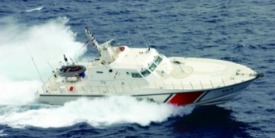
(CNSNews.com)—It has been 117 months since a major hurricane, defined as a Category 3 or above, has made landfall in the continental United States, according to 2015 data from the Hurricane Research Division of the National Oceanic and Atmospheric Administration (NOAA).
This is the longest span of time in which no major hurricane has struck the mainland U.S. in NOAA hurricane records going back to 1851.
The second longest time between major hurricane strikes was the eight years between 1860 and 1869—146 years ago.
A recent study published May 5 and co-authored by Tim Hall of the National Aeronautics and Space Administration’s (NASA) Goddard Institute for Space Studies entitled The Frequency and Duration of U.S. Hurricane Droughts also confirmed that the current “admittedly unusual” drought is “unprecedented in the historical record.”
That study found that major hurricane droughts only occur every 177 years, and calculated that there is less than a 5 percent chance (0.39%) that the current drought will end this hurricane season, which lasts from June 1 to November 30.
Hurricane Wilma, the most recent major hurricane to strike the U.S., was a Category 3 when it made landfall in North Carolina on October 24, 2005—almost 118 months ago.
Since the end of the 2005 hurricane season, the U.S. has experienced a nine-year major hurricane “drought,” which is approaching 10 years at the end of the 2015 season this November.
Last month, Eric Blake, a hurricane specialist at NOAA’s National Hurricane Center, told CNSNews.com that this is “easily the record—with all the necessary caveats.”
Blake co-authored NOAA’s The Deadliest, Costliest, And Most Intense United States Tropical Cyclones from 1851 to 2010 report, which explains that “category assignment is based on wind speed from 1851-1930 and 1990-2010 and on a combination of wind, pressure and storm surge from 1931-1989.”
The Saffir-Simpson Hurricane Wind Scale assigns categories from 1 to 5 based on sustained wind speeds and potential for damage. The scale was developed in 1969, so storms before then were assigned categories retroactively, using the historical measurements on record.
Blake told CNSNews.com that measurements for storm categorizations have improved over time.
While a Category 3 or greater storm has not struck the U.S. since Wilma in 2005, several hurricanes of lesser wind speeds have still caused considerable damage, including Ike in 2008 (Category 2), Irene in 2011 (Category 1), and Sandy in 2012 (Category 1).
According to NOAA, Category 1 storms cause “some damage” with sustained winds between 74-95 mph, and Category 2 storms cause “extensive damage” with winds between 96 and 110 mph.
Category 3, 4, and 5 hurricanes are considered “major” because of their ability to produce “devastating” and “catastrophic damage” with wind speeds of 111-129 mph, 130-156 mph, and 157 mph or higher, respectively.
“Small differences today that we could detect, you couldn’t detect a long time ago,” Blake told CNSNews.com. “Given that we just see things a little better, we‘ve got more data and better satellite data, we can give a little better estimate than we could a generation ago.”
“But nonetheless, it is a record. It’s easily the record,” he continued.
That a 117-month pause in major hurricane activity follows the most active Atlantic hurricane season in history is “an unlikely event, so ascribing the significance of it is a challenge,” Blake told CNSNews.com.
“I like to think of it as Mother Nature giving us a little bit of a break after giving us a beating in 2004 and 2005.
That’s my best guess, but I don’t know.”













































































































































































